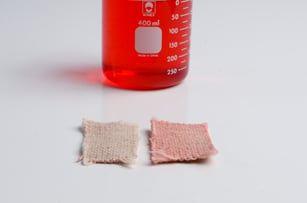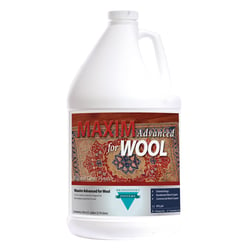In a recent conversation with Gordon Hanks, the past chief executive officer (CEO) of Bridgewater, I learned that the carpet cleaning business they started almost 40 years ago was based on the principle of “cleaning carpet so that we could sell protectors.”
At The Experience trade show in Las Vegas, I manned the carpet protector demonstration table and asked attendees if they cleaned carpets so that they could sell protectors. Most immediately understood the point I was making, but there were a few that appeared baffled by the question. It was generally understood, after some explanation, that if you clean a carpet for an hour that you can boost your profit by 50 percent in just five minutes by applying a protector.-1.jpg?width=300&name=My%20Post%20(11)-1.jpg)
To some of our visitors to the booth, I asked another obvious question. “What are the issues with nylon and wool fibers that have created a need for protection?” Or, in other words, what preinspection condition was of utmost concern to both the cleaner and the owner of the carpet? The common responses were “extreme soiling,” which is usually a combination of soil and oil; “staining” (nylon and wool have dye sites) from a variety of organic and synthetic stains, and “extreme issues with urine contamination.” A protector for nylon and wool carpets should provide oil and water repellency, protection against abrasive dry soils, anti-resoiling, and stain resistance or release.
The stain resistance or release comes from the use of an acid dye resistor, which essentially is a colorless dye that fills vacant dye sites. The concept works by limiting the number of dye sites that can be filled by staining material. The science of fluorochemistry prevents any protector from being great at all these requirements.
Based on my experience in the industry, it is readily apparent that extreme soiling is the easiest issue to effectively solve. Staining and/or urine contamination will be the primary concerns of the cleaner and the owner of the carpet. If staining will be the primary concern, then we need to use a protector that best limits these issues in the long term. In short, for protecting nylon and wool carpets, you can easily argue that stain resistance or release would be the primary feature that you will want in this type of protector.
The Best Choice
Surface repellency has long been oversold, in my opinion, for use on carpet. I recognize that this is probably the most important feature of an upholstery protector and a stone sealer. However, in the real world, stains easily overcome surface repellency. Most spills on the carpet start from two to four feet above the carpet surface. The volume and weight of the spill break most of this surface tension immediately. This often is not an issue if the spill is wiped up within just a few minutes.
However, in many situations, if the owner of the carpet is not immediately aware of the situation, then the staining material quickly overcomes the repellency and leaves a stain. When hot liquids are spilled, they penetrate almost immediately. Protectors, which provide the best surface repellency, generally allow the carpet to re-soil at a faster rate than if no protector was applied. For example, solvent-based protectors designed for upholstery provide outstanding surface repellency but are known for having softer polymers. The soft nature of these polymers will result in re-soiling.
The majority of the water-based protectors for carpets have an excellent profile in limiting re-soiling. Some of these protectors will have the typical level of repellency and limited stain resistance and release.
Another group of protectors will have excellent stain resistance and release and limited levels of surface repellency. Some of these formulas will have some fiber repellency as demonstrated by oil penetrating the surface, but not entering the fiber, but instead going only into the backing. This discussion should lead you to conclude that the best type of protector for nylon and wool fiber is a formula whose strengths are stain and soil resistance with limited surface repellency.
Common Problems
In our industry, cleaning technicians do not sell protectors as frequently as they should. The reasons can vary, but lack of conviction about the effectiveness and value of protectors is a primary concern. We recognized this concern and developed a demonstration kit that shows in dramatic fashion the value of acid dye resistors.
One issue with conviction about the use of protectors is that they are sprayed on the carpet shortly before the technician leaves. The cleaner is not able to observe how well they work overtime. I have often said that some carpet protectors sold in our industry would not survive if they were compared to common products, such as presprays. An average prespray will be quickly called out by cleaners as worthless as they will see large gaps in performance.
Our suggestion is to put your protector to the test. Simply use untreated carpet squares to test your protectors. It is easy to compare different brands for repellency and stain resistance. Soil resistance is best seen by applying the product to a light-colored small area rug that has no protection. Spray different protectors on designated areas and place them in a high-traffic areas. Rotate the rug often to try and equalize foot traffic and come to a conclusion over time.
Once you have decided on your protector for nylon and wool carpet, based on performance, we suggest that you let your techs clean their own homes and apply protectors everywhere. This will allow them, on a daily basis, to see the advantages of protector, and also gives them war stories to share with customers on how the protector worked for them. When you match conviction with special bonuses and a powerful demonstration, then you will see your protector sales climb through the roof.
End game
In short, you want to clean carpets to sell protectors for the health of your company and for prolonging the useful life of your customer’s furnishings. Remember that a good protector is better than no protector. However, I believe that you need to determine which product best protects the carpet that you clean. Thorough testing by everyone in your company will help you make that choice.
This process will also build conviction in the use of protectors among your employees, which will naturally result in increased sales. A company that cleans carpets to sell protectors will be a profitable venture for all involved.
Featured Products
 Bridgepoint Systems Carpet Protector Maxim Advanced For Wool, 1 Gallon
Bridgepoint Systems Carpet Protector Maxim Advanced For Wool, 1 Gallon
